#place de la nation square
Explore tagged Tumblr posts
Text

Place de la Nation Square in Paris during a festival
French vintage postcard
#carte postale#postkarte#paris#square#historic#postcard#sepia#ansichtskarte#postkaart#tarjeta#nation#briefkaart#place#ephemera#photography#place de la nation square#festival#vintage#french#postal#photo
4 notes
·
View notes
Text
📍Nice,French Riviera,France 🇫🇷
Here's why it should be at the top of your list!
Things to do in Nice:
Promenade des Anglais – Stroll along the famous seaside boulevard.
Old Town (Vieux Nice) – Explore the narrow streets and colourful markets.
Castle Hill (Colline du Château) Enjoy panoramic views of Nice and its surroundings.
Marc Chagall National Museum Discover the works of the famous artist.
Place Masséna – Visit the central square with beautiful architecture.
Cours Saleya Market - Experience the bustling flower and food market.
Port Lympia – Wander around the picturesque harbour.
Parc Phoenix - Relax in the botanical garden with exotic plants and animals.
Mont Boron – Hike for stunning views of Nice and the Mediterranean.
Lunch at Le Plongeoir.
🚗Day-Trips from Nice:
1. Monaco:
Just a short train ride away, Monaco offers glitz and glamour with its famous casino, the opulent Monte Carlo district, and the Prince's Palace.
2. Cannes:
Known for its international film festival, Cannes boasts lovely beaches, a charming old town, and a glamorous waterfront promenade, La Croisette. 30 minutes by🚊
3. Antibes:
Antibes is known for its old town enclosed by 16th-century ramparts, the Picasso Museum housed in the Château Grimaldi, and the luxury yacht-filled Port Vauban. 20 minutes by🚊
4. Eze:
A mediaeval village perched high on a cliff above the Mediterranean, Eze offers stunning views, quaint streets, and the exquisite Jardin Exotique. Accessible by a short bus or train ride followed by a hike or a local bus up to
the village.
5. Saint-Paul de Vence:
This famous art village is known for its art galleries, picturesque streets, and historical charm. 45 minutes🚗
6. Menton:
Often referred to as the "Pearl of France". 40 minutes by.🚊
7. Villefranche-sur-Mer:
A charming coastal town known for its picturesque old town, vibrant harbour, and stunning beaches. 15 minutes by.🚊
🎥@zenwander
#visitnice #frenchrivieraplaces
#traveleurope #voyaged
#frenchriviera #southoffrance
#travelfrance #cotedazur
#frenchrivieralife #frenchsummer
#summereurope
#beautifuldestinations
Bonjour France 🇫🇷
24 notes
·
View notes
Text
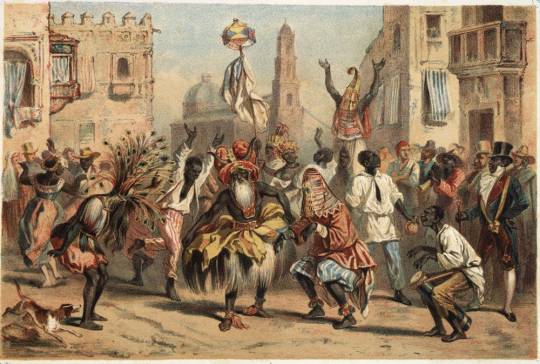
Long before it arose in New York City and became an influential style of music around the world, salsa music has its seeds in African rhythms and traditions that came to the Caribbean through the slave trade. Centuries of enslavement caused many cultural changes in Cuba, including the music that led to salsa.
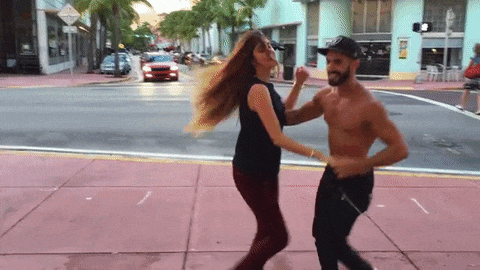
Some people know Bobby Day’s 1958 “Rockin’ Robin” or Michael Jackson’s remake but the origin of the song goes back to the days of slavery.
The majority of the Africans that were enslaved and brought to the Americas were of West African descent where the drum was used as a form of communication. In the Americas, enslaved Africans used the drum in the same way — communicating with the enslaved on distant plantations and ultimately planning uprising.
The enslavers caught wind of this and enacted a ban.
It is absolutely necessary to the safety of this Province, that all due care be taken to restrain Negroes from using or keeping of drums, which may call together or give sign or notice to one another of their wicked designs and purposes. — Slave Code of South Carolina, Article 36
That ban went down in 1740 and soon spread throughout Colonial America.
But the beat is in the heart of the African.
We soon found other ways to imitate the sound of the drum; stomping, playing spoons, washboards, or anything other household item. We also “slapped Juba” or played “hambone” where the body became an instrument where the player slaps their thighs and chest for the drum beat. (How did young boys in 1980s Park Hill, Denver know “Hambone?”)
Although we kept the beat, we lost the tradition, a cultural marker snatched away from us.
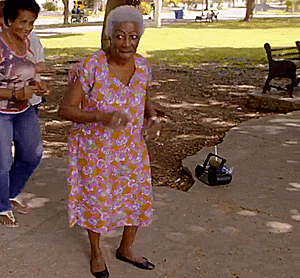
While the American enslaver worked feverishly to destroy any vestige of African culture, the Spanish enslaver of Cuba felt that it was in his best interest to allow the enslaved African to maintain his culture. In support of that, the Spanish allowed the Africans to organize Cabildos (or social groups) based on their nation of origin. Thus you had the Abakua (or Ekpe) from the nations known as Nigeria and Cameroon, the Madinga (or Malinke) from Sierre Leone, etc.
Our focus is primarily on the Lucumi, the Cabildo founded for the Yoruba of Benin and Nigeria. This lineage would be the cornerstone and origin point for what is now called “Salsa.” And what is this “Salsa?”
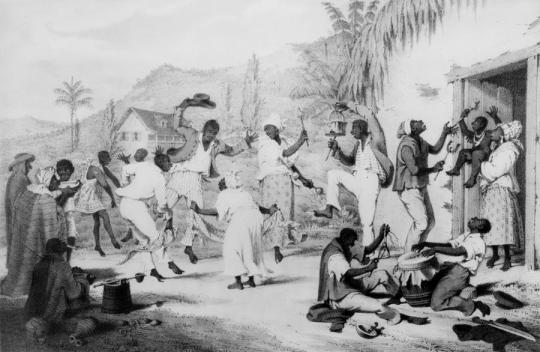
When we spoke of the drum being forbidden among the enslaved Africans in America, we forgot to mention that there was one place that didn’t enact that ban. That place was the port city of New Orleans, Louisiana — some even call New Orleans the Northernmost Caribbean city.
Similar in the way that the Spanish allowed for Cabildos in Cuba, the Louisiana enslavers permitted Sundays off and were okay with the dance and celebration so long as the enslaved African did so outside of the city limits in a place called Place des Negres (eventually known as Congo Square).
After the Civil War, Africans in America were able to get a hold of surplus brass instruments and shortly thereafter began composing music based on the popular music in the Caribbean at the time, the Cuban Habanero. Many say that this is one of the foundations of jazz music itself and the basis of the habanero, the tressilo, can be heard in second lines. Self-proclaimed jazz inventor, Jelly Roll Morton had this to say:
Now take the habanero “La Paloma”, which I transformed in New Orleans style. You leave the left hand just the same. The difference comes in the right hand — in the syncopation, which gives it an entirely different color that really changes the color from red to blue. Now in one of my earliest tunes, “New Orleans Blues”, you can notice the Spanish tinge. In fact, if you can’t manage to put tinges of Spanish in your tunes, you will never be able to get the right seasoning, I call it, for jazz. Jelly Roll Morton
Because of those qualities, a young musical prodigy from Cuba, Mario Bauzá recognized the similarities between jazz and Cuban music straightaway. Bauzá fell in love with jazz having heard it on Cuban radio but it was his trip to Harlem, NYC in 1927 that convinced him that New York was where he wanted to be and jazz was the music that he wanted to play.
Bauzá returned to New York in 1930, immediately found work, eventually landing a gig in the Cab Calloway band. Here he brought on the legend in the making, Dizzy Gillespie, and the two became fast friends. Bauzá attempted to play his “native” music to many in the band but they dismissed it as “country” music. Gillespie, on the other hand, embraced it.
For the next eight years Bauzá played in predominately African jazz bands having seen discrimination from white Cubans. Yet he longed to start a group that incorporated the music from his home and his second love, jazz. He shot this idea to his childhood friend/brother-in-law and in 1939 at the Park Palace Ballroom the Machito Afro-Cubans would debut.
“I am Black, which means my roots are in Africa. Why should I be ashamed of that?” Bauzá said in reference to the name.
Bauzá replaced the drum kit, which at that time had only been around for 20 years, with the hard to find congas, timbales, and toms. “The timbales play the bell pattern, the congas play the supportive drum part, and the bongos improvise, simulating a lead drum”. In the 40s these drums could only be found at Simon Jou’s bakery, La Moderna, locally known in East Harlem simply as Simon’s.
Next, the Afro-Cubans needed a home and they would find that not in Harlem nor the Bronx, but instead in Midtown Manhattan, a club called the Palladium.

Salsa is a set of Afro-Caribbean rhythms fused with jazz and other styles. The truth is that its origins have always been much debated, although as a general rule it is mentioned that it comes from a fusion that came from Africa in the Caribbean when they heard European music and wanted to mix it with their drums
These origins focus especially on mambo, danzó, cha cha chá, guaracha and son montuno, later enriched with instruments such as saxophone, trumpet or trombone.
It was the Cuban exiles and those from Puerto Rico who popularized salsa in New York back in the 1950s. But it wasn't until the last third of this century that salsa dancing began to take off all over the world.
Cuba played a leading role in the origin of salsa. Already in the 1930s, melodies and rhythms from Africa were playing on the Caribbean island. Among them was the danzón, a musical piece acquired by the French who had fled Haiti.
History tells us that it was these first rhythms that were then mixed with rumbas such as guagancó and sonero to begin to create their own Afro-Cuban rhythms, including Afro-Cuban jazz, mambo, guaracha, Cuban son and montuno.
The exquisite melody of these new rhythms soon set in other Latin American countries. Puerto Rico and Colombia were the first to welcome these new sounds from the Cuban country.
However, it was not until their appearance in the United States, and more specifically in the Bronx neighborhood of New York, when these rhythms acquired a greater impact. It was the moment in which new musical instruments were added that today form an indissoluble part of salsa.
The great Cuban musicians who moved to New York along with the wave of these new rhythms created the famous��tumbadoras, congas or son montuno, and were responsible for introducing trombones and guaracha.
The Origin of the Salsa Dance Steps
Once salsa was defined as a musical genre in the 1970s, the movements and steps of its dance were collected through a fusion of the African with the European.
These steps and movements of salsa fundamentally reflect the influence of the dances that the Africans brought to the Caribbean and the European dances that have been danced in Cuba since the 1930s.
So much so that the basic steps of salsa are precisely the same steps as the Cuban son, just as it also includes steps that can be seen in rumba, danzón and mambo.
The origin of these variants is in the regions where this style comes from, which are the ones that developed each dance, always under the same umbrella of the term salsa.
It is not surprising, then, that salsa is defined as the result of a series of social conditions and the evolution of a series of rhythms and melodies from Cuba, which were developed and achieved repercussion in the United States.
There are those who assure against this mixture that salsa is neither a rhythm nor a style, but rather a term that serves to represent all the music of Afro-Cuban origin that emerged in the first decades of the twentieth century.
In short, the origin of salsa has always been, and will continue to be, much discussed. American musician Tito Puente was right when he said, "Salsa doesn't exist. What they now call salsa is what I have played for many years, and this is mambo, guaracha, cha cha chá and guagancó".
#salsa#cuba#congo#nigeria#african#afrakan#kemetic dreams#brownskin#africans#afrakans#brown skin#african culture#afrakan spirituality#nigerian#nigerians#ghana#niger#cameroon#senegal#west africa#afro cuban#american#african american#african american history#american history#dance#african dance#congo dance#ekik#yoruba
22 notes
·
View notes
Text
The Republic of Rose Island (Esperanto: Respubliko de la Insulo de la Rozoj; Italian: Repubblica dell'Isola delle Rose, both literally "Republic of the Island of the Roses") was a short-lived micronation on a man-made platform in the Adriatic Sea, 11 kilometres (6.8 mi) off the coast of the region of Emilia-Romagna, Italy, built by Italian engineer Giorgio Rosa, who made himself its president and declared it an independent state on 1 May 1968.[1][2]
In 1958, Italian engineer Giorgio Rosa funded the construction of a 400-square-metre (4,300 sq ft) platform supported by nine pylons and furnished it with a number of commercial establishments, including a restaurant, bar, nightclub, souvenir shop, and post office, with construction being completed in 1967.[6]
Rosa's actions were viewed by the Italian government as a ploy to raise money from tourists while avoiding national taxation. Whether or not this was the real reason behind Rosa's micronation, the Italian government's response was swift: On 26 June 1968, 55 days after the island declared independence, the Italian navy sent a group of four carabinieri and Guardia di Finanza officers, who assumed control, cleared the island, and set up a blockade so no one could re-enter.[7][8]
At first, the Italian government tried to dismantle the island, but they found it impossible, so they decided to blow it up instead. The Italian Navy bombed the island twice, with the first time failing, and the second bombing taking place on 13 February 1969,[9] but the island still stood. Afterward, Rosa's self-declared government in exile created stamps depicting the events. Rosa was billed by the Italian government for war costs. Finally, on 26 February 1969, the island was toppled by a storm. Only one death was counted but never confirmed: apparently, Rosa's dog was on the platform during the facility's detonation.[8]
15 notes
·
View notes
Text
In this month of October 1802, a slave revolt was led, among others, by three white men against the reinstatement of slavery by Bonaparte in Guadeloupe
Sensitive souls should abstain when I speak about the fate of Millet ( one of the white men leader of the slave revolt). I have already talked about the revolt against the reinstatement of slavery led by Delgrès, Ignace, and Alexandre Kirwan in several posts here: Link 1, Link 2, and a mini-post on the forgotten French revolutionary Alexandre Kirwan, who played a key role in this revolt: Link 3.
Now, I am looking for more information on the October 1802 revolts. In fact, in Sainte-Anne, there was a rebellion of Black people led, among others, by three white men: Barse, Millet de la Guardière, and Jean Barbet.
Here is an excerpt from Frédéric Régent regarding these three men: “Ménard, who replaced Richepance after his death as Commander-in-Chief of the army, mentions here his expulsion from Guadeloupe by Lacrosse on April 18, 1803. October 6, 1802, refers to the revolt of Sainte-Anne, triggered by three white leaders: Barsse, Millet de la Girardière, and Jean Barbet. During the general freedom period, Barsse was a government commissioner and tenant of the Gassien estate, which belonged to the heirs of Vipart; Millet de la Girardière was a former French officer, a colonist from Martinique, who had been expelled from there due to his political ideas, which were likely republican; Jean Barbet, a native of Antenac in Gascony, was a farmer. Mulattoes Yves (without a last name), Louis Bureau, Jean Gautier, René Gayan, and Louison Bourk, as well as Black men Hippolyte, Édouard, and Jean (Barsse's servant), were part of the conspiracy. They traveled to twenty plantations, recruiting insurgents on each: their numbers swelled to eighty, with twenty on horseback. Twenty-three white people were killed by the insurgents. It is not specified whether they were returning emigrants. The revolt was suppressed by the National Guard. According to Ménard, there was a strong opposition between tenants and returning emigrants. In this regard, he said: ‘I considered Grande-Terre as the battleground of tenants and landlords.’”
According to a site, 23 settlers were killed by the rebels, and in four months, there were more than a hundred executions in retaliation.
Millet allegedly met a horrific fate (sensitive souls should abstain, I say again): he was sentenced to the iron cage punishment by a Guadeloupe tribunal. Here’s an excerpt: “A tribunal in Guadeloupe, by judgment of 11 Brumaire, Year XI (November 2, 1802), condemned Millet de la Girardière to be exposed in the square of Pointe-à-Pitre, in an iron cage, until death ensued. The cage used for this punishment is eight feet high. The victim is placed astride a sharp blade; his feet rest on stirrup-like supports, and he is forced to keep his legs tense to avoid being wounded by the blade. In front of him, on a table within his reach, food and drink are placed, but a guard watches day and night to prevent him from touching them. When the victim’s strength begins to wane, he collapses onto the sharp blade, which inflicts deep and cruel wounds. The unfortunate man, driven by pain, rises again, only to fall once more onto the sharp blade, which wounds him horribly. This torture lasts three or four days.” (Joseph Elzéar Morenas, Précis historique de la traite des Noirs et de l’esclavage colonial, 1828)
So, I would like more information about this rebellion and especially about another one. A very knowledgeable site, although it doesn’t cite its sources (unfortunately, since upon in-depth verification, the information is usually accurate), mentions Fourme, who had already participated in the resistance alongside Delgrès, Ignace, etc. Palème, who followed a similar path, managed to escape. From there, Fourme established a stronghold in which the fight against the reinstatement of slavery continued on Morne Moudongue, then in the heights of Capesterre, before being betrayed and handed over by settlers in November 1805 . So we have proof that the revolt against the reestablishment of slavery lasted even after May 1802. The Guadeloupeans may not have succeeded in winning militarily against Napoleon unlike Haiti (and even then it was difficult to beat them, Richepance half-admitted that he had totally underestimated them to the point of asking England for material aid) but they succeeded for many years at the cost of sacrifice and ordeals to finally succeed in having slavery definitively abolished (which is still less great than that of 1794, the former owners had the right in 1848 to have financial compensation for the loss of their slaves but the former slaves did not have the right to the slightest financial compensation upon their return). May they never be forgotten.
If you have more information on him, I would be very grateful :)
7 notes
·
View notes
Text
Greg Owen at LGBTQ Nation:
Across France on Sunday, thousands rallied for trans rights in the wake of calls by right-wing senators to ban hormone therapy and puberty blockers for trans youth. A coalition of LGBTQ+ activists, left-wing members of parliament, trade unionists, and young people joined protests in Paris, Lyon, Marseille, and Montpellier, the Ministry of the Interior reported. Over 10,000 demonstrators turned out, with the largest group gathered at Paris’s Place de la République, an 8.4-acre public square popular for protests. “Anti-patriarchy, anti-capitalism, solidarity with trans people all over the world!” protesters chanted in the French capital, according to Le Monde. The Socialist Party and left-leaning La France Insoumise party were among more than 800 groups and individuals calling for demonstrations.
[...] Anti-trans legislation has appeared in the French Parliament in the wake of a report on trans minors commissioned by fringe lawmakers in the right-wing Les Républicains party, the French publications Le Figaro and Le Point reported on March 18. The legislation calls for a ban on gender-affirming hormone therapy and puberty blockers, commonly prescribed to trans youth to combat gender dysphoria. Most major American medical associations consider such care safe, effective, and necessary for the well-being of trans minors.
Senator Jacqueline Eustache-Brinio called gender-affirming care for trans youth a “growing phenomenon in the media and in public life,” while claiming “all” foreign countries are rejecting the life-saving treatments. Their claim is untrue. “Today, it is done too quickly, young people are steered toward a transition too quickly. Instead, they need to be accompanied regarding their unease and encouraged to seek psychiatric care,” the senator said. The aforementioned report, written by the Observatoire de la Petite Sirène (“Little Mermaid Observatory”), an organization notoriously opposed to gender-affirming care for minors, is replete with alarmist language, calling the practice a “health scandal,” and “social contagion,” while highlighting painful “de-transitions.”
Pro-trans protests erupted all over France on Sunday over a proposed ban on gender-affirming care, in which the proponents of the proposed ban justify its proposal with pushing baseless canards, such as the nonexistent “social contagion” myth.
#France#World News#LGBTQ+#Protests#Anti Trans Extremism#Gender Affirming Healthcare#Social Contagion Myth#Hormone Replacement Therapy#Puberty Blockers#Place de la République#Observatoire de la Petite Sirène
12 notes
·
View notes
Photo






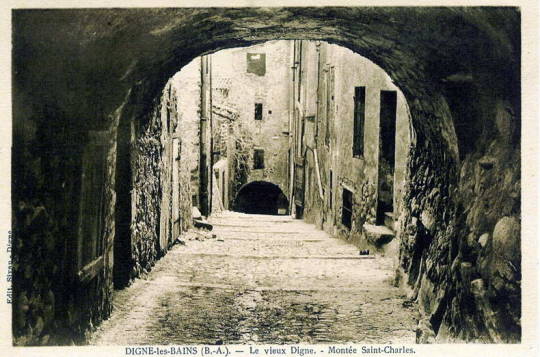

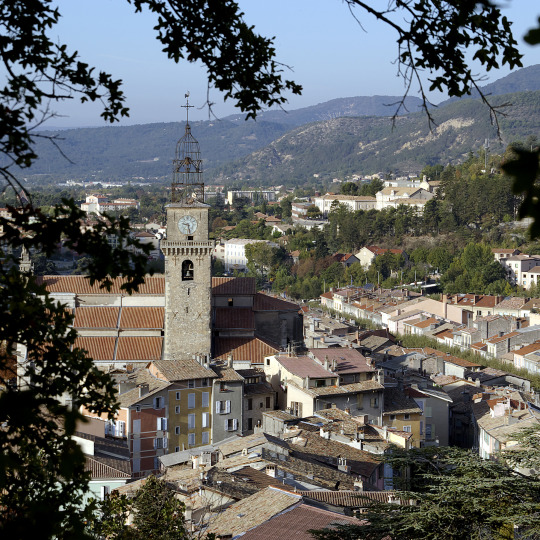
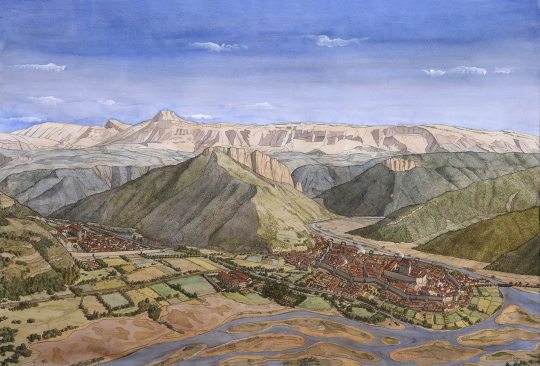
Digne in the era of Les Misérables
An engraved print of a scenic view of the city of Digne-les-Bains from a traveller's guide published in 1838
A coloured military map of Digne with the buildings marked from between 1820 and 1866
The old episcopal palace of Digne, a postcard from 1898 to 1900
An old photo of the old Place de l'Évêché
An early 20th century map of Digne, showing a lot more detail but way too new for our purposes, dated 1921
An old photograph of Digne
An old photograph of a sloping street with archways through buildings
A screenshot from Les Misérables 1925 showing another narrow sloping street surrounded by small houses
A view of the Cathedral St. Jérôme with its strange wire dome, photograph from 2007 by Denis Champollion
Digne in the late 14th / early 15th century, an artist's impression by Jean-Claude Golvin
Digne-les-Bains (or Dinha dei Banhs in the local Occitan language) is a small city in Province, in southeastern France. Centered on top of a hill, it’s surrounded by mountains on all sides and the river Bléone (Blèuna) flows past it (or nowadays rather through it as the city has spread on the other side of the river).
The 1925 movie adaptation of Les Misérables actually filmed the Digne scenes on location in Digne which is a great opportunity to see some authentic views of the city! (The movie is available in the Internet Archive.)

More under the cut:
Unfortunately I wasn’t able to find contemporary maps of Digne, except for this one from a Carte générale de la France (Cassini de Thury) that is luckily from exactly the right year (1815) but doesn’t really help much because it doesn’t really show much detail of the city and it’s also very difficult to read:
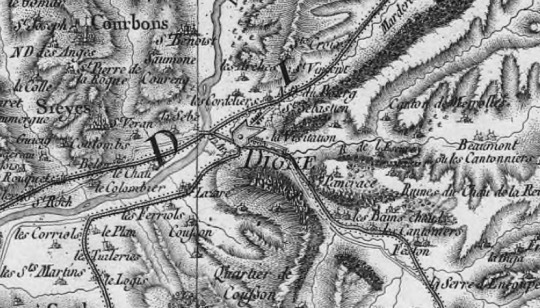
The Carte de l’état-major 1820-1866 is much more vague in terms of date, but I find it more useful:

I would be willing to guess that it’s probably still fairly close to Digne in 1815. Aside from the lack of walls, which I don’t think you can see on this map, but definitely would have been there in 1815. Hugo even mentions the walls:
He retraced his steps; the gates of Digne were closed. Digne, which had sustained sieges during the wars of religion, was still surrounded in 1815 by ancient walls flanked by square towers which have been demolished since.
I was also able to find a map from 1921, which is over a century later, but it’s the oldest proper map of the city I could track down: (Here zoomed in to focus on the old city)
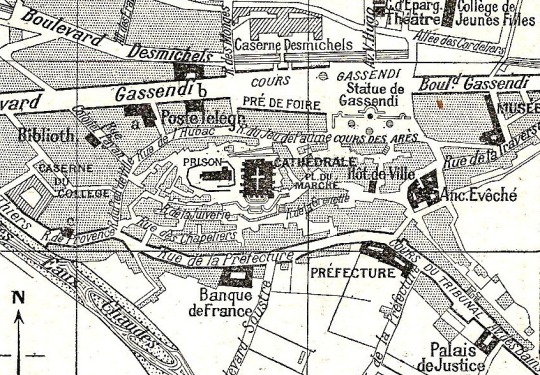
From something too recent to something much too old: an artist’s impression of medieval Digne, which actually shows the city walls:

There would have been more roads and streets and buildings outside of the walls in 1815, including the Boulevard Gassendi, which Hugo also mentions, as well as a bridge over the Bléone, but honestly it seems like the city actually hadn’t grown that much over the centuries.
It would grow over the course of the 19th century, though.
I’ll talk a little bit more later about the cathedral, the episcopal palace, etc. This post is getting too long!
Image Sources:
Digne-les-Bains official website (Jean-Claude Golvin)
Wikipedia / Wikimedia Commons (photographs by Denis Champollion, Szeder László)
Carte générale de la France (Cassini de Thury) from BNF Gallica
Guide pittoresque du voyageur en France (Eusèbe Girault de Saint-Fargeau) from BNF Gallica
Carte de l’état-major 1820-1866 from Géoportail (Institut national de l’information géographique et forestière)
Carte de la Provence (1921) : Digne (Les Guides bleus, Hachette, édition 1922)
Présentation de Digne-les-Bains from France Geo
dignois . fr / Digne-vieux
Les Misérables (1925)
112 notes
·
View notes
Note
Hola, a friend and I are thinking about doing a sightseeing trip to Madrid in the middle of november. Do you have some insider tips what we should see? :)
hi anon, yes of course !!!
so, one thing about madrid, it isn't a monument city but a walking city. i'd say walking through the city center, centered around the two main squares, puerta del sol and plaza mayor (both also massive tourist hotspots so expect a ton of people). just walking around that area, around arenal street, calle mayor (main street), carretas street and others is enough to get a feel of the oldest part of the city (also called 'madrid the los austrias' or 'austrian madrid', when spain was ruled by the habsburgs). it's my favourite area honestly, alongside the barrio de las letras, which you can get to walking or in a few metro stops. its name translates to 'neighborhood of the letters' because a ton of writers lived here, and you can find phrases from spanish literary classics engraved on the streets, it's lovely.

apart from that central area, other cool spots i would really recommend you should check out is gran vía (busiest street in the city, it literally translates to 'broadway', it has a ton of theatres as well), malasaña (hip arts district, love the vibe, also it's so beautiful and there's always stuff going on, really nice place to go out at night as well), chueca (next to malasaña, it's the queer district!!! also very beautiful), debod (my actual favourite place in the city!!!!!! it's this hill that holds an egyptian temple - the temple of debod - that was gifted to spain after the aswan campaign, you can visit it and also the views from the city from here are lovely, you can find the best sunset here), el rastro (the largest flea market in the country, you can visit it every sunday, you can find anything here. also nearby, in the cuesta de moyano, there's a book fair also open only on sundays), retiro park (our main park, really pretty, it's very nice to just chill; it also has a lake you can row on, and cool statues and stuff), and the royal palace (it's open to the public if that's your thing, but the area around it is very very nice, i always end up here when i hang out with my friends).

now let's talk museums!!!! madrid has a ton of museums, i'll tell you the ones i recommend but depending on what you're looking for there's probably something for you. important to note is that at least the prado and the reina sofía museums are free everyday one hour before they close !!!!!! important !!!!!! check in case there's other museums that do this, but i'm unsure, i think it's those two and maybe the thyssen?
so. the main three art museums in madrid are the prado museum (the counterpart of the louvre, that sorta vibe), the reina sofía museum (our modern art museum, only stuff from picasso onwards), and the thyssen museum (ngl i haven't been here, it's a private museum made out of the collection of this one countess). all of them (more or less) are in the prado boulevard, which is also very nice to walk by so it's always lovely to go there even if you don't enter the museums. nearby there's also the national archaeological museum, my personal favourite one.
other smaller but also cool museums that i love are the madrid history museum (the facade is insane, also has tons of cool maps of the city), romanticism museum (an old romanticism-era palace with romanticism-era paintings and other stuff), cerralbo museum (underrated af; it is the personal collection of this one noble, the building itself is absolutely insane), and the sorolla museum (if you like sorolla this is your place!).

(i'm nearly done i swear)
if you have time and want to visit a nearby city, my recommendations are: alcalá de henares (really close to madrid, it has the second oldest university in spain, with a medieval feel to it, it also has the madrid archaeological museum - it was a roman foundation under the name of complutum - and most importantly, it's known for being the birthplace of miguel de cervantes, writer of don quijote!!!! you can visit his house, it's now a museum :), el escorial (deep in the mountains, it has the monastery of el escorial, maximum icon of spanish renaissance, it was the winter palace of the monarchy and holds the royal crypt, where most of spanish monarchs have been buried), toledo (oh if you love medieval cities you'll love this one. it was the first capital of spain, and it is most known for being the city that during the medieval times had christians, muslims and jews living peacefully. there's tons of churches, mosques and synagogues to visit, and it is very well preserved, with narrow steep cobblestone streets, cannot recommend it enough), and segovia (toledo is to the south of madrid, and segovia to the north! it is most famous for its roman aqueduct, the best preserved and highest in the country, and it also has a ton of historical buildings, including its alcázar, a palace that inspired the sleeping beauty castle !!!!!). also it's not a city but there's a national park in madrid, the sierra de guadarrama national park and it's super beautiful, it's this lovely mountainous area perfect for hiking or just chilling, and depending on when in november you come, you might see snow!
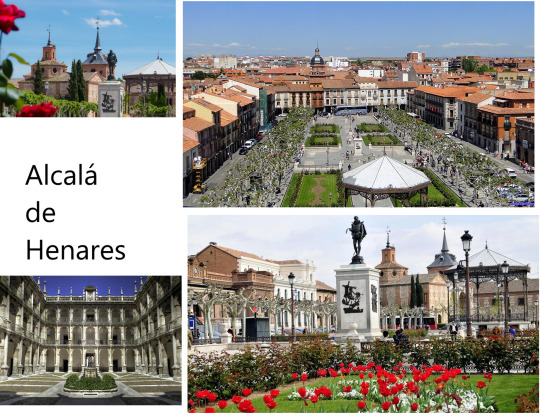




as a final warning!! i don't know where you're from but in november madrid is probably colder than you are expecting so make sure to pack some extra layers just in case !!!
#ask#madrid#sorry for the long post anon. but you asked for it#(but again. sorry)#hope this is helpful!#and if you have something in particular in mind of some kind of activity or a kind of place of visit#let me know so i can further help#also about guadarrama !!!#the national park is just part of the mountain range of the guadarrama mountains#and personally i haven't been to the park but i've been to other places in the guadarrama mountains and i can't recommend them enough#just going anywhere in the mountains is <3333#i would recommend the hayedo de montejo (the southernmost beech forest in europe!)#the boca del asno which is a popular picnic spot#navacerrada is the most famous ski town. maybe it will be opened in november but i'm unsure? there's cool trekking paths tho and it's easy#to get to via public transport#also !!!! la pedriza !!! which is this cool mountain (?) group of mountains (?) with these big rock formations that look funny#and there's a ton of mountain goats there as well.#anddd in the town where la pedriza is located (manzanares el real) is a really cool castle used by the templars#one of the best preserved medieval castles i've been to#definitely the best one in madrid#i almost added manzanares el real to the list of places to see next to madrid but it didn't feel important enough#there's also other places as well like again. if you want more info about specific stuff feel free to let me know!!!#also with public transport you should be able to get everywhere. the metro is (maybe a bit confusing) pretty reliable
2 notes
·
View notes
Text

⚜ State funeral of His Majesty Emperor Napoléon IV of Francesim ⚜
This is the official funeral process of His Majesty, Emperor Napoléon IV of Francesim. It is inspired by the funerals of the kings of France and the emperors of the French in the 19th century, all modernised. It is the first televised imperial and royal funeral of the Francesim.
Invitations to the event and the dress code will be distributed privately shortly. #funeralnapoléoniv
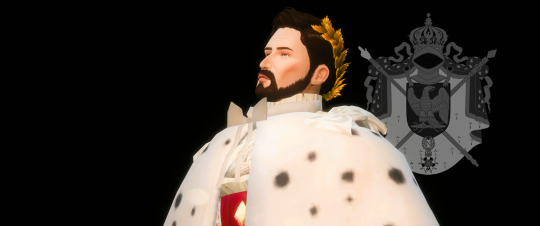
⚜ General chronology
23 Germinal: Vigil in front of the Tuileries Palace, open coffin, in the square courtyard of the Louvre Palace after the Pont des Arts in an ephemeral chapel. 24 Germinal: Departure of the imperial coffin from the Tuileries Palace. Crossing of Paris and arrival of the imperial coffin at the cathedral of Notre-Dame de Paris. Imperial mass given by the archbishop of Paris then opening of the access to the public. From 24 Germinal to 29 Germinal: Vigil at Notre-Dame de Paris, open coffin. The imperial family collects the tributes paid to the Emperor Napoléon IV on the national territory. 29 Germinal: Arrival of foreign dignitaries in Paris. A minute's silence is observed throughout the country. Military parade given in honour of the Emperor Napoléon IV. 30 Germinal in the morning at 11 am: Crossing of Paris and arrival of the imperial coffin at the hotel of the Invalides under the blows of cannons and the sound of the funeral bells. The military procession is led by the new Emperor, himself preceded by the imperial family (apart from the widow, Madame Mère, Marie-Joséphine) and the princes of the Empire as well as the great French officers. During this time, the foreign dignitaries take their places in the Hôtel des Invalides. 30 Germinal at 12 noon: Official state funeral. At the end of the ceremony at about 3 p.m., the heralds will shout "The Emperor is dead!" and the whole of the Hôtel des Invalides and the whole of Francesim will shout "Long live the Emperor!" when the new Emperor leaves the chapel.
⚜ Official plaque on the coffin of Emperor Napoléon IV
Napoléon IV Emperor of the French Born in Brussels on 23 July 1970 Died in the Tuileries Palace Paris 22 March 2022 R.I.P.
⚜ What next?
31 Germinal: In the evening, His Imperial Majesty will give a televised speech in tribute to His Majesty the late Emperor Napoléon IV and informs the new order of succession. 1 Floréal: The new Emperor of the French officially presents himself before Parliament. The Prime Minister will then give a speech in Parliament in the presence of His Imperial Majesty. The date of the coronation will be announced on this day. 2 Floréal: The heart of Emperor Napoleon IV, previously separated from the body of His Imperial Majesty, becomes a sacred Catholic relic, and is placed in its tomb (cardiotaph) in a chapel in the Hôtel des Invalides.
▬ Version Française ▬
Voici le déroulement officiel des funérailles de Sa Majesté, l'Empereur Napoléon IV de Francesim. Il est inspiré des funérailles des rois de France et des empereurs des Français du XIXe siècle, le tout modernisé. Il s'agit des premières funérailles impériales et royales télévisées de la Francesim.
Les invitations à l'événement et le dress code seront distribuées prochainement en privé.
⚜ Chronologie générale
23 Germinal : Veillée en face du palais des Tuileries, cercueil ouvert, dans la cour carrée du palais du Louvre après le Pont des Arts dans une chapelle éphémère. 24 Germinal : Départ du palais des Tuileries du cercueil impérial. Traversée de Paris et arrivée du cercueil impérial à la cathédrale Notre-Dame de Paris. Messe impériale donnée par l'archevêque de Paris puis ouverture de l'accès au public. Du 24 Germinal au 29 Germinal : Veillée à Notre-Dame de Paris, cercueil ouvert. La famille impériale recueille les hommages rendus à l'Empereur Napoléon IV sur le territoire national. 29 Germinal : Arrivée des dignitaires étrangers à Paris. Une minute de silence sera observée dans tout le pays. Défilé militaire donné en l'honneur de l'Empereur Napoléon IV. 30 Germinal au matin à 11 heures : Traversée de Paris et arrivée du cercueil impérial à l'hôtel des Invalides sous les coups de canons et le son des cloches funèbres. Le cortège militaire est dirigé par le nouvel Empereur, lui-même précédé de la famille impériale (hormis la veuve, Madame Mère, Marie-Joséphine) et des princes de l'Empire ainsi que de grands officiers français. Pendant ce temps, les dignitaires étrangers se placent dans l'hôtel des Invalides. 30 Germinal à 12 heures : Funérailles d'Etat officielles. A la fin de la cérémonie vers 15 heures, les hérauts d'armes crieront "L'Empereur est mort !" et tout l'hôtel des Invalides et toute la Francesim clameront "Vive l'Empereur !" lorsque le nouvel Empereur quittera la chapelle.
⚜ Plaque officielle sur le cercueil de l'Empereur Napoléon IV
Napoléon IV Empereur des Français Né à Bruxelles le 23 juillet 1970 Mort au palais des Tuileries Paris le 22 mars 2022 R.I.P
⚜ Et après ?
31 Germinal : Le soir, Sa Majesté Impériale donnera un discours télévisé en hommage à feu Sa Majesté l'Empereur Napoléon IV et informe le nouvel ordre de succession. 1 Floréal : Le nouvel Empereur des Français se présente officiellement devant le Parlement. Le Premier Ministre donnera ensuite un discours au Parlement en présence de Sa Majesté Impériale. La date du couronnement sera renseignée durant cette journée. 2 Floréal : Le coeur de l'Empereur Napoléon IV, séparé au préalable du corps de feu Sa Majesté Impériale, devient une relique catholique sacrée, et rejoint son tombeau (cardiotaphe) dans une chapelle de l'hôtel des Invalides.
#simparte#gen 2#funeralnapoléoniv#sims 4#sims 4 fr#ts4#ts4 fr#ts4 royal#ts4 royalty#royal sims#sims 4 royal#sims 4 royalty
32 notes
·
View notes
Text
Places to Visit: Segunda: A City Divided.

Beautifully painted sign at the entrance of the town, Segunda, Cruz Del Salvador, Valle de Oro; Picture by @mynonsenseistingling.
Segunda is the largest city in the province of Cruz Del Salvador in the central region of Valle de Oro. It is home to music, culture, and is rich in our history. This article will take you on a virtual tour of this bustling and lively city.
Main Attractions
Architecture, Shops, etc
There is not one main attraction in Segunda. Rather many small streets surrounding a central square, El Toro Square, featuring brightly painted buildings of Spanish colonial architecture. Taking a stroll through the streets of Segunda is considered by many the town’s main attraction, where you will find shops, restaurants, bars, and old classic cars. The people of Segunda are generally quite friendly and approachable.


FND Recruitment Offices building, Segunda.
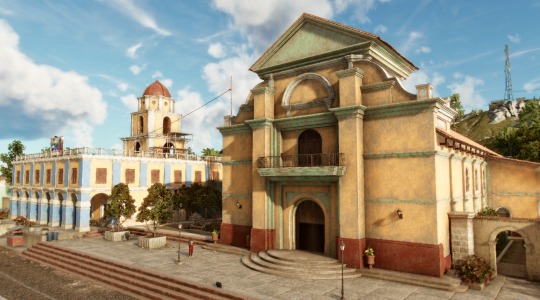
Another Church with no name, let's call it La Iglesia de Segunda
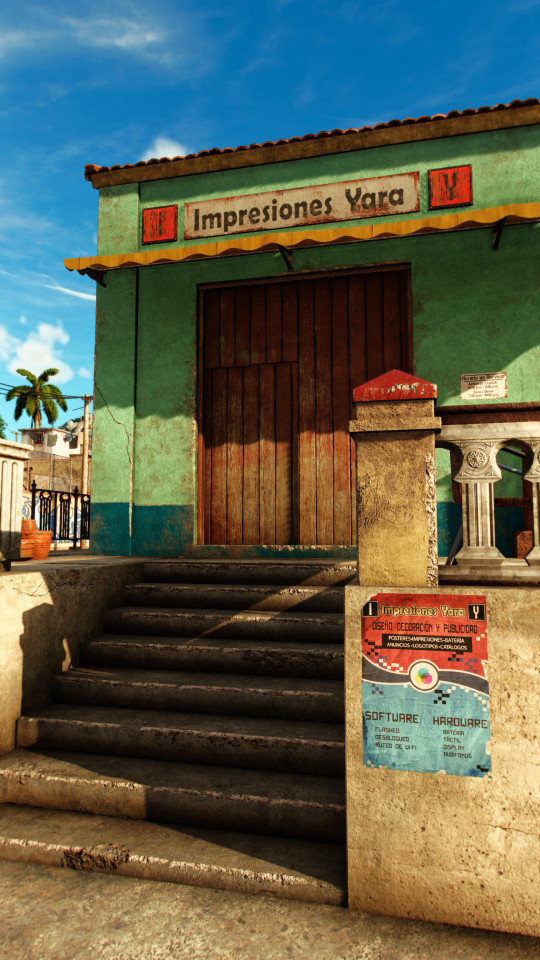
One of many businesses in Segunda; Picture by @mynonsenseistingling.
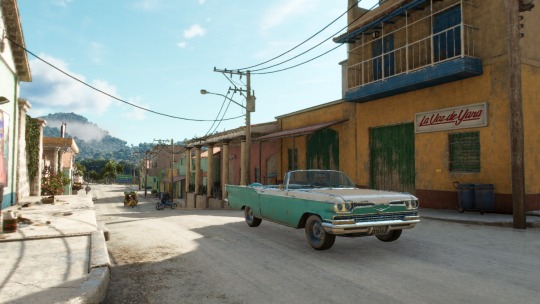
Awh the classic cars... What would be life in Yara without them?
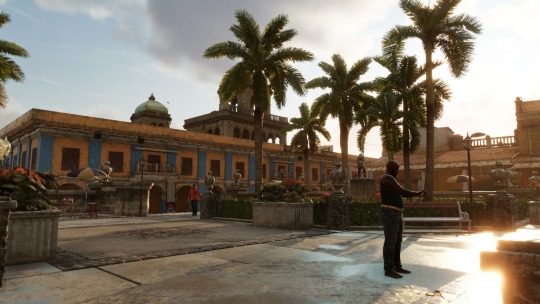
A tourist takes a picture in El Toro Square, Segunda.
And of course, who says public town square says some fellow trying to sell you something. However, Segunda being much more touristy, you will find people selling refresco, food, and of course cigars. Buy some!

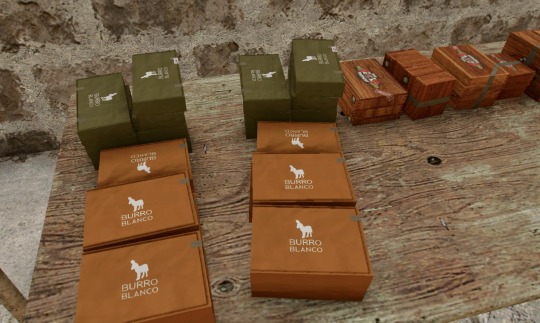
Where to Stay
Back to Content Index
We searched long and hard but were unable to locate any good places to stay within Segunda. The closest venues are located a short drive around El Tiburón Lagoon. There is a peninsula with many options including the prestigious El Tigre Dormido Hotel. Check local listings for pricing and availability. Also we were told the pool might be closed for maintenance.

El Tigre Dormido Hotel, Burros Bay, Cruz Del Salvador, Yara.
Where to Eat
Good eateries are not hard to find around the city. Just walk around and you will come across many cafes and cantinas. We recommend the Taberna El Escritor Jalado among others.


Taberna El Escritor Jalado, Opened during curfew hours; Segunda.
If you are in the mood for a little adventure and want to try something different, you can check out Los Langostinos Cafe located a short drive north of the city. As the name suggests, they serve fresh langoustines. This author has not personally tried it due to an allergy to shellfish but it looks like a decent place with a large terrace overlooking an old plantation that is still operational today. Plenty of parking at the bottom of the hill and you will need to climb a few stairs to get there, but it’s good para tu trasero.
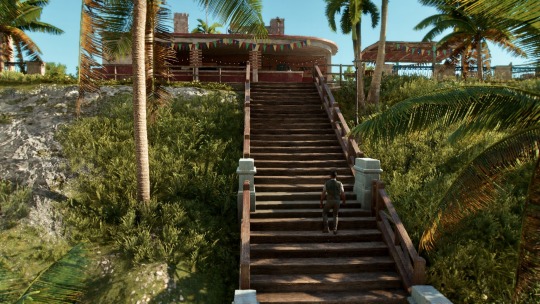

Los Langostinos Cafe, Cruz Del Salvador, Valle de Oro, Yara.
Art and Culture
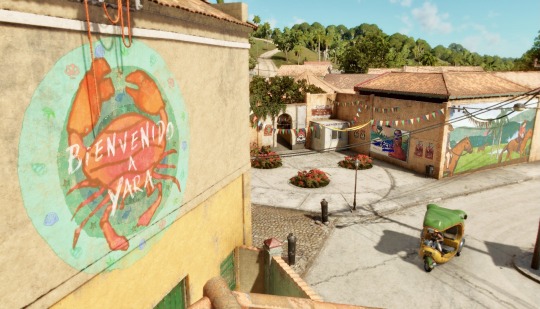
Mural painted on the side of a building, Segunda, Yara.

Mural by local artist, Segunda; Picture taken by @mynonsenseistingling.
You will toss a pebble in Segunda and find a beautiful mural or piece of art by local artists. (But not the metal statues. We do not talk about the metal statues.)

This authoritarian-looking monument was apparently given to Yara by the, at the time, USSR, in 1974 and represents “the country’s new, modern pursuits born from its past” or something; Picture by @mynonsenseistingling.
Historical stuff square
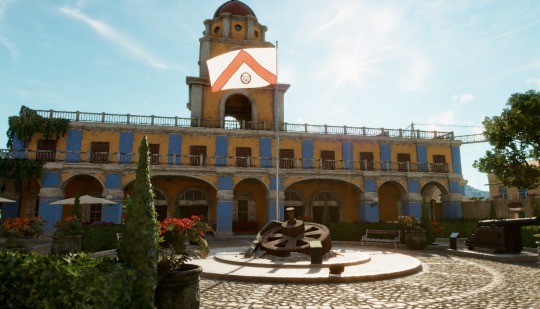
You will find an inner courtyard with various artifacts and plaques with bits and pieces of our history. You can go read them but in a nutshell, they recount how Segunda used to be surrounded by many sugar plantations in the 1800’s. “Settlers in the Caribbean used rum as currency in the New World.” Slaves were brought into Yara from east Africa by the Spanish settlers to work the sugar cane plantations. A pretty common historical thread among Caribbean nations except ours has a little bit more “controlling” leaders.
Segunda After Hours
The streets are dead after hours, mainly due to the curfew in place. Curfew starts at 9:00pm and is in effect until 6:00am. But it is not hardcore psycho curfew and it is certainly not as violently enforced as in other towns, but there are armed soldados patrolling after dark.


They will ask you where you are going and may apprehend you if you are visibly inebriated or if they’re just in a mood and they don’t like your face.

A citizen breaking curfew is being searched. She may or may not have a bad day;
However, despite the curfew order in Segunda, on some evenings, government approved live music shows are still running at a bar that is mainly frequented by military service men and women. Maybe that's why they aren't tooooo adamant about enforcing it.
Segunda: A City Divided
Segunda is an interesting place because the people are very polarized when it comes to politics. Perhaps because there is an FND Recruiting Office in town, there is a particularly strong pro-Castillo sentiment amongst citizens. Wear a blue scarf in the street, and you might even be cat-called a traitor.

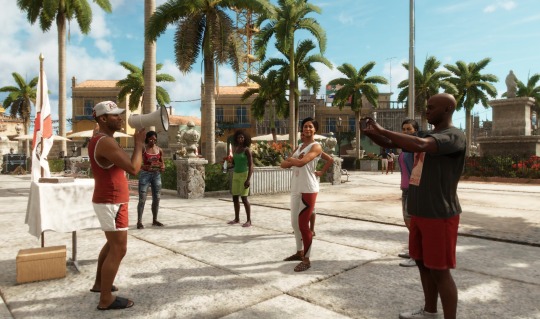

Pro-Castillo rallies are common in El Toro Square, Segunda, Yara.
This is met by an equally vehement anti-Castillo sentiment, visible in the many anti-government graffiti and general disobedience and mischief. However, this should not affect you as a tourist. Avoid appearing overly pro or con and generally try to leave our politics to our people. This is true across the rest of Yara as well.

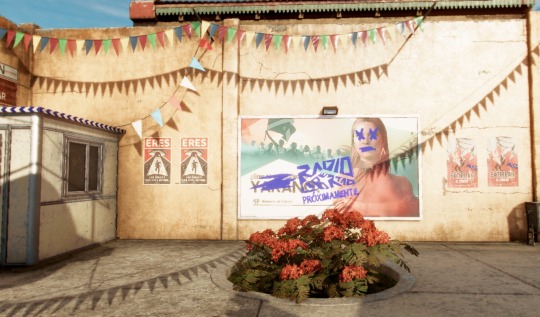
We hope that you enjoyed this tour of Segunda. For more information on activities, places, events, and all things Yara, consult our content index at the top of this page. Follow this page and come back often for more content!

This photo encompasses all of the chaotic beauty that is Segunda in one glance.
Special Acknowledgement
A special thanks to our guest photographer, @mynonsenseistingling, who graciously provided some of the shots for this article and for being one of our agency’s first and most faithful supporters.

A side road to Segunda; Picture by @mynonsenseistingling
Editor's Note:
We did visit inside of the FND Recruiting Office. The lady at the counter gave us the side eye.

And later on, some FND recruiter briefly took us in his car. Poor fellow probably thought we were interested in enlisting. Sorry, hermano. Already did our time and paid our dues. Sweet ride though.

Back to Content Index
#visityaratoday#visit yara#visityara#far cry 6#far cry#virtual photography#far cry series#virtualtourism#virtual travel#vprt#farcry6
7 notes
·
View notes
Text

Exhibition: The Body of Memory (El Cuerpo de la Memoria)
October 12 @ 18:00 – December 1 @ 17:00 LONDON
An exhibition by performance artist Janet Toro’s radical work responding to Chilean dictatorship at
Peltz Gallery 43 Gordon Square Birkbeck College London WC1H 0PD
Exhibition opens on October 12 at 6pm and runs until December 2023
Janet Toro’s performance series El cuerpo de la memoria (The body of memory), rekindles both individual and collective consciousness of the coup d’etat in Chile – that took place 50 years ago. This exhibition of photography and video documentation of performances refers back to 1999, when the artist presented 90 performance-installations as part of the second Biennale of Young Artists that was held at the National Museum of Fine Arts in Chile. Walking barefoot for kilometres and subjecting herself to physical constraints, Janet Toro pointed out sites of political detention and torture implemented during the civil-military dictatorship in Chile. Pushing at the limits of her body, Toro experienced 62 methods of torture, that recollected the horrors employed by the dictatorial apparatus to suppress and obliterate anything deemed a threat to their project. Such methods are the basis of Toro’s radical works.
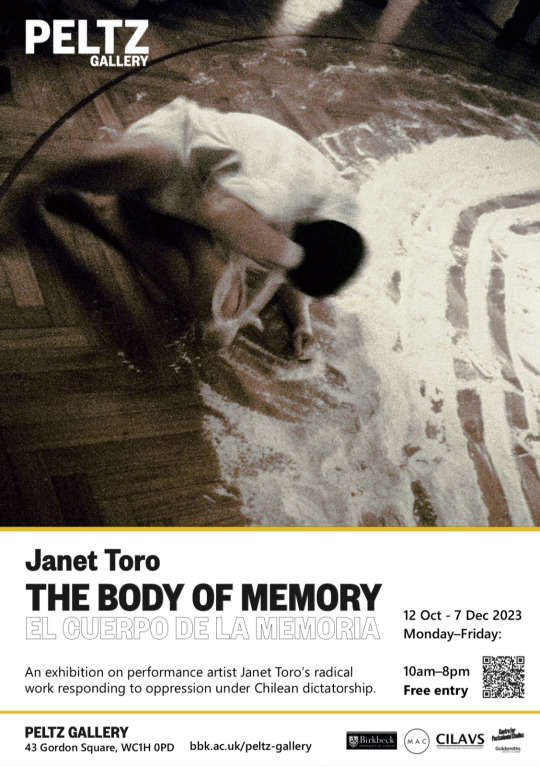
The Performances and Installations were made inside and outside the museum at places related to torture and detention. Additionally I did barefoot walks from those places to the museum and from the museum to those places, through the city of Santiago.

I always walked with some physical sign of limitation of the body, tying my legs or my arms, etc., walked miles in silence and carrying a fragment of a white canvas stained with blood of slaughtered animal (as a shroud), which I had used 9 years earlier, in the Performance: "The blood, the river and the body", at the riverside of Mapocho River, at the height of Pio Nono Bridge, Santiago, 1990. This canvas I kept for 9 years and later I used it, teared it, fragment and knotted it in these performances.
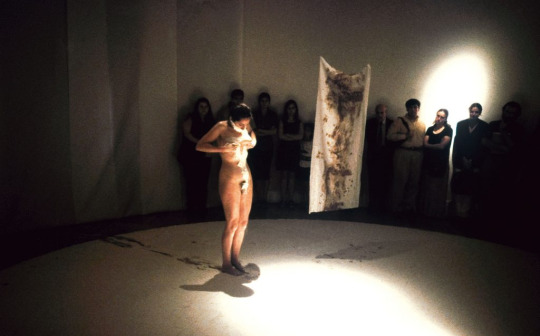
For this cycle I realized a long investigation about various methods of torture, which were practiced systematically in Chile during the Military Dictatorship and which are currently used in many countries of the world. These methods of torture form the basis of my performances-installations, in which I approach the limits of my body and social limits, therefore there was an experience of permanent risk. There was no rehearsal.
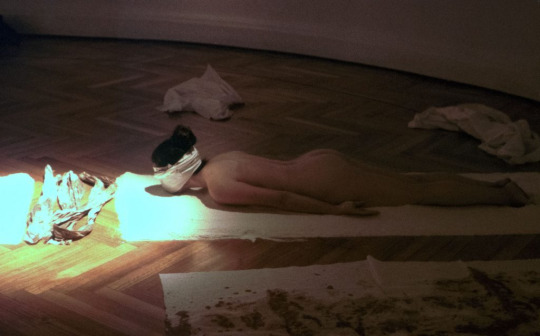
This work makes an inner journey to the pain that underlies the collective memory, to the pain that was inflicted on thousands of people, through torture and the systematic violation of human rights in our country.

These actions expose the memory as a corporal and emotional echo, through mute minimum acts, opening the folds of the dark memories of that harsh reality, attached to the organism. Memory is not only a functional activity of the mind, but a bodily experience: "we remember with the body". That is the premise of this work.


3 notes
·
View notes
Text

Place de la Nation Square in Paris
French vintage postcard, mailed in 1906 to Moulins
#ephemera#mailed#photography#vintage#briefkaart#paris#square#carte postale#place#french#moulins#postcard#photo#sepia#ansichtskarte#place de la nation square#postkarte#nation#postkaart#1906#postal#tarjeta#historic
1 note
·
View note
Text
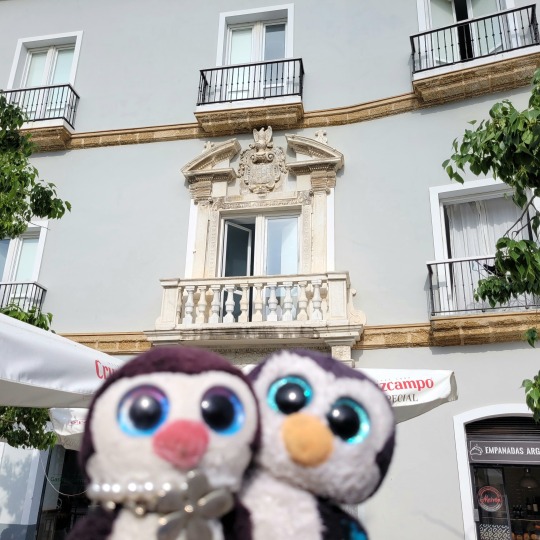
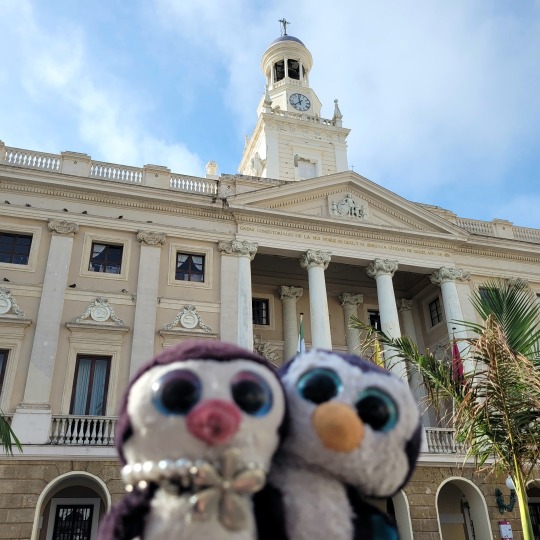
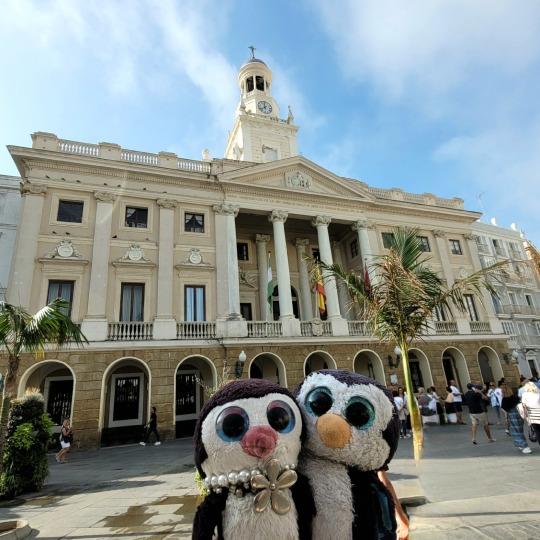

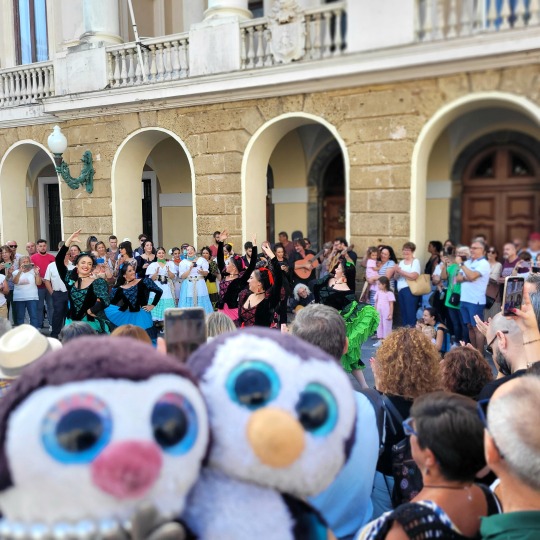





2023/10/14 Seguimos por el paseo desde la plaza del Ayuntamiento hacia el centro. Encontramos el homenaje a una persona que estuvo secuestrada por el último grupo terrorista nacional que hubo en España. Llegamos a la plaza de la catedral, donde se encuentra el límite del barrio más antíguo de Occidente.
We continue along the walk from the Town Hall square towards the center. We find a tribute to a person who was kidnapped by the last national terrorist group that existed in Spain. We arrive at the cathedral square, where the limit of the oldest neighborhood in the West is located.
Google Translation into French: Nous continuons la promenade depuis la place de la Mairie en direction du centre. Nous trouvons un hommage à une personne qui a été kidnappée par le dernier groupe terroriste national qui existait en Espagne. Nous arrivons sur la place de la cathédrale, où se situe la limite du plus vieux quartier de l'Ouest.
Google translation into Italian: Continuiamo la passeggiata dalla Piazza del Municipio verso il centro. Troviamo un omaggio a una persona rapita dall'ultimo gruppo terroristico nazionale esistente in Spagna. Arriviamo in Piazza del Duomo, dove si trova il confine del quartiere più antico d'Occidente.
Google Translation into Portuguese: Continuamos a caminhada desde a Praça da Câmara Municipal em direção ao centro. Encontramos uma homenagem a uma pessoa que foi sequestrada pelo último grupo terrorista nacional que existiu em Espanha. Chegamos à Praça da Sé, onde fica o limite do bairro mais antigo do Oeste.
Google Translation into German: Da es ein langes Wochenende war, herrschte viel Partystimmung auf den Straßen. Flamenco-Tanzgruppen führten künstlerische Vorführungen vor, um die Seelen der Besucher zu erhellen.Wir setzen den Spaziergang vom Rathausplatz in Richtung Zentrum fort. Wir finden eine Hommage an eine Person, die von der letzten in Spanien existierenden nationalen Terroristengruppe entführt wurde. Wir kommen am Domplatz an, wo sich die Grenze des ältesten Viertels im Westen befindet.
Google Translation into Albanisch: Duke qenë se ishte një fundjavë e gjatë, në rrugë kishte shumë atmosferë feste. Grupet e vallëzimit të Flamenkos po kryenin demonstrime arti për të ndriçuar shpirtrat e vizitorëve.
Google Translation into Arabic: نواصل السير من ساحة قاعة المدينة باتجاه المركز. نجد تحية لشخص اختطفته آخر جماعة إرهابية وطنية كانت موجودة في إسبانيا. وصلنا إلى ساحة الكاتدرائية، حيث تقع حدود أقدم منطقة في الغرب.
Google Translation into Armenian: Շարունակում ենք քայլարշավը Քաղաքապետարանի հրապարակից դեպի կենտրոն: Մենք հարգանքի տուրք ենք գտնում մի մարդու, ով առևանգվել է Իսպանիայում գոյություն ունեցող վերջին ազգային ահաբեկչական խմբավորման կողմից: Հասնում ենք տաճարի հրապարակ, որտեղ գտնվում է Արևմուտքի ամենահին թաղամասի սահմանը։
Google Translation into Bengali: আমরা টাউন হল স্কোয়ার থেকে কেন্দ্রের দিকে হাঁটা চালিয়ে যাই। স্পেনে বিদ্যমান সর্বশেষ জাতীয় সন্ত্রাসী গোষ্ঠী দ্বারা অপহৃত হওয়া একজন ব্যক্তির প্রতি আমরা শ্রদ্ধা খুঁজে পাই। আমরা ক্যাথেড্রাল স্কোয়ারে পৌঁছেছি, যেখানে পশ্চিমের প্রাচীনতম পাড়ার সীমা অবস্থিত।
Google Translation into Bulgarian: Продължаваме по разходката от площада на кметството към центъра. Откриваме почит към човек, който е бил отвлечен от последната национална терористична група, съществувала в Испания. Пристигаме на площада на катедралата, където се намира границата на най-стария квартал на Запад.
Google Translation into Czech: Pokračujeme procházkou z Radničního náměstí směrem do centra. Nacházíme poctu osobě, která byla unesena poslední národní teroristickou skupinou, která existovala ve Španělsku. Přijíždíme na náměstí s katedrálou, kde se nachází hranice nejstarší čtvrti na Západě.
Google Translation into Simplified Chinese: 我们继续沿着市政厅广场向市中心步行。 我们向被西班牙最后一个国家恐怖组织绑架的人致敬。 我们到达大教堂广场,这里是西部最古老街区的边界所在。
Google Translation into Korean: 우리는 시청 광장에서 중앙 방향으로 계속 걸어갑니다. 우리는 스페인에 존재했던 마지막 국가 테러 단체에 의해 납치된 사람에 대한 추모를 찾습니다. 서쪽에서 가장 오래된 동네의 한계가 위치한 대성당 광장에 도착한다.
Google Translation into Croatian: Nastavljamo šetnju od trga Vijećnice prema centru. Nalazimo posvetu osobi koju je otela posljednja nacionalna teroristička skupina koja je postojala u Španjolskoj. Dolazimo do trga katedrale, gdje se nalazi granica najstarije četvrti na Zapadu.
Google Translation into Danish Vi fortsætter ad gåturen fra Rådhuspladsen mod centrum. Vi finder en hyldest til en person, der blev kidnappet af den sidste nationale terrorgruppe, der eksisterede i Spanien. Vi ankommer til katedralpladsen, hvor grænsen for det ældste kvarter i Vesten ligger.
Google Translation into Slovak: Pokračujeme prechádzkou z Radničného námestia smerom do centra. Nachádzame poctu osobe, ktorá bola unesená poslednou národnou teroristickou skupinou, ktorá existovala v Španielsku. Prichádzame na námestie s katedrálou, kde sa nachádza hranica najstaršej štvrte na Západe.
Google Translation into Slovenian: Pot nadaljujemo od Mestne hiše proti centru. Najdemo poklon osebi, ki jo je ugrabila zadnja nacionalna teroristična skupina, ki je obstajala v Španiji. Prispemo do katedralnega trga, kjer je meja najstarejše soseske na Zahodu.
Google Translation into Estonian: Jätkame jalutuskäiku Raekoja platsilt kesklinna poole. Leiame austusavalduse inimesele, kelle röövis viimane Hispaanias eksisteerinud rahvuslik terrorirühmitus. Jõuame katedraali väljakule, kus asub lääne vanima linnaosa piir.
Google Translation into Suomi: Jatkamme kävelyä Raatihuoneentorilta kohti keskustaa. Löydämme kunnianosoituksen henkilölle, jonka viimeinen Espanjassa ollut kansallinen terroristiryhmä sieppasi. Saavumme katedraaliaukiolle, jossa sijaitsee lännen vanhimman kaupunginosan raja.
Google Translation into Georgian: ჩვენ ვაგრძელებთ გზას მერიის მოედნიდან ცენტრისკენ. ჩვენ ვპოულობთ ხარკს პიროვნებისადმი, რომელიც გაიტაცეს ესპანეთში არსებულმა ბოლო ნაციონალურმა ტერორისტულმა დაჯგუფებამ. მივდივართ საკათედრო ტაძრის მოედანზე, სადაც მდებარეობს დასავლეთის უძველესი უბნის ლიმიტი.
Google Translation into Greek: Συνεχίζουμε τη βόλτα από την πλατεία του Δημαρχείου προς το κέντρο. Βρίσκουμε ένα αφιέρωμα σε ένα άτομο που απήχθη από την τελευταία εθνική τρομοκρατική ομάδα που υπήρχε στην Ισπανία. Φτάνουμε στην πλατεία του καθεδρικού ναού, όπου βρίσκεται το όριο της παλαιότερης γειτονιάς στα Δυτικά.
Google Translation into Guarani: Jasegi pe jeguata pukukue Ayuntamiento plaza guive centro gotyo. Jajuhu peteî tributo peteî tapicha ojesecuestrava'ekue grupo terrorista nacional paha oîva'ekue España-pe. Roguahẽ plaza catedral-pe, oĩháme límite barrio itujavéva Occidente-pe.
Google Translation into Hawaiian: Ke hoʻomau nei mākou i ka hele wāwae mai ke kahua o ke kūlanakauhale a i ke kikowaena. ʻIke mākou i ka mahalo i kahi kanaka i ʻaihue ʻia e ka hui hoʻoweliweli aupuni hope loa i noho ma Sepania. Hōʻea mākou i ka hale pule nui, kahi i loaʻa ai ka palena o ke kaiāulu kahiko loa ma ke Komohana.
Google Translation into Hebrew: ממשיכים בהליכה מכיכר העירייה לכיוון המרכז. אנו מוצאים מחווה לאדם שנחטף על ידי קבוצת הטרור הלאומית האחרונה שהתקיימה בספרד. אנחנו מגיעים לכיכר הקתדרלה, בה נמצא גבול השכונה הוותיקה במערב.
Google Translation into Hindi: हम टाउन हॉल चौराहे से केंद्र की ओर पैदल यात्रा जारी रखते हैं। हम उस व्यक्ति को श्रद्धांजलि देते हैं जिसका स्पेन में मौजूद आखिरी राष्ट्रीय आतंकवादी समूह ने अपहरण कर लिया था। हम कैथेड्रल स्क्वायर पर पहुंचते हैं, जहां पश्चिम के सबसे पुराने पड़ोस की सीमा स्थित है।
Google Translation into Hungarian: Folytatjuk a sétát a Városháza tértől a központ felé. Találunk egy tisztelgést egy személy előtt, akit az utolsó Spanyolországban létező nemzeti terrorista csoport elrabolt. Megérkezünk a katedrális térre, ahol Nyugat legrégebbi negyedének határa húzódik.
Google Translation into Indonesian: Kami melanjutkan perjalanan dari alun-alun Balai Kota menuju pusat. Kami menemukan penghormatan kepada seseorang yang diculik oleh kelompok teroris nasional terakhir yang ada di Spanyol. Kami tiba di alun-alun katedral, tempat batas lingkungan tertua di Barat berada.
Google Translation into Japanese: 市庁舎広場から中心部に向かって散歩を続けます。 スペインに存在した最後の国家テロ組織によって誘拐された人物への追悼文を見つけた。 私たちは西部最古の地区の境界がある大聖堂広場に到着します。
Google Translation into Kyrgyz: Мэрия аянтынан борборду көздөй басууну улантабыз. Биз Испанияда болгон акыркы улуттук террористтик топ тарабынан уурдалган адамга урмат табабыз. Биз батыштагы эң эски микрорайондун чеги жайгашкан собор аянтына келебиз.
Google Translation into Latvian: Turpinām gājienu no Rātslaukuma uz centru. Mēs atrodam cieņu personai, kuru nolaupīja pēdējais nacionālais teroristu grupējums, kas pastāvēja Spānijā. Nonākam katedrāles laukumā, kur atrodas Rietumu vecākās apkaimes robeža.
Google Translation into Malayalam: ടൗൺ ഹാൾ സ്ക്വയറിൽ നിന്ന് മധ്യഭാഗത്തേക്ക് ഞങ്ങൾ നടത്തം തുടരുന്നു. സ്പെയിനിൽ നിലനിന്നി��ുന്ന അവസാനത്തെ ദേശീയ ഭീകരസംഘം തട്ടിക്കൊണ്ടുപോയ ഒരു വ്യക്തിക്ക് ഞങ്ങൾ ആദരാഞ്ജലി അർപ്പിക്കുന്നു. ഞങ്ങൾ കത്തീഡ്രൽ സ്ക്വയറിൽ എത്തിച്ചേരുന്നു, അവിടെ പടിഞ്ഞാറൻ പ്രദേശങ്ങളിലെ ഏറ്റവും പഴയ അയൽപക്കത്തിന്റെ പരിധി സ്ഥിതിചെയ്യുന്നു.
Google Translation into Malay: Kami meneruskan perjalanan dari dataran Dewan Perbandaran menuju ke pusat. Kami mendapati penghormatan kepada seseorang yang diculik oleh kumpulan pengganas negara terakhir yang wujud di Sepanyol. Kami tiba di dataran katedral, di mana had kejiranan tertua di Barat terletak.
Google Translation into Malagasy: Manohy ny dia an-tongotra avy eo amin'ny kianjan'ny Lapan'ny tanàna mankany afovoany. Mahita fanomezam-boninahitra ho an'ny olona iray nalain'ny vondrona mpampihorohoro nasionaly farany nisy tany Espaina izahay. Tonga teo amin'ny kianjan'ny katedraly izahay, izay misy ny fetran'ny faritra tranainy indrindra any Andrefana.
Google Translation into Mongolian: Бид Хотын танхимын талбайгаас төв рүү алхаж байна. Испанид оршин байсан сүүлчийн үндэсний террорист бүлэглэлд хулгайлагдсан хүнд хүндэтгэл үзүүлж байна. Бид барууны хамгийн эртний хорооллын хязгаар байрладаг сүмийн талбайд ирлээ.
Google Translation into Dutch: We vervolgen de wandeling vanaf het Stadhuisplein richting het centrum. We vinden een eerbetoon aan een persoon die werd ontvoerd door de laatste nationale terroristische groepering die in Spanje bestond. We komen aan op het Domplein, waar de grens van de oudste wijk van het Westen ligt.
Google Translation into Nepali: हामी टाउन हल स्क्वायरबाट केन्द्र तर्फ हिड्दै जारी राख्छौं। हामीले स्पेनमा रहेको अन्तिम राष्ट्रिय आतंकवादी समूहले अपहरण गरेको व्यक्तिलाई श्रद्धाञ्जली पाउँछौं। हामी क्याथेड्रल स्क्वायरमा आइपुग्छौं, जहाँ पश्चिमको सबैभन्दा पुरानो छिमेकको सीमा अवस्थित छ।
Google Translation into Norwegian: Vi fortsetter langs turen fra Rådhusplassen mot sentrum. Vi finner en hyllest til en person som ble kidnappet av den siste nasjonale terrorgruppen som fantes i Spania. Vi kommer til katedralplassen, der grensen for det eldste nabolaget i Vesten ligger.
Google Translation into Panjabi: ਅਸੀਂ ਟਾਊਨ ਹਾਲ ਚੌਕ ਤੋਂ ਕੇਂਦਰ ਵੱਲ ਪੈਦਲ ਚੱਲਦੇ ਰਹਿੰਦੇ ਹਾਂ। ਸਾਨੂੰ ਇੱਕ ਵਿਅਕਤੀ ਨੂੰ ਸ਼ਰਧਾਂਜਲੀ ਮਿਲਦੀ ਹੈ ਜਿਸਨੂੰ ਸਪੇਨ ਵਿੱਚ ਮੌਜੂਦ ਆਖਰੀ ਰਾਸ਼ਟਰੀ ਅੱਤਵਾਦੀ ਸਮੂਹ ਦੁਆਰਾ ਅਗਵਾ ਕੀਤਾ ਗਿਆ ਸੀ। ਅਸੀਂ ਕੈਥੇਡ੍ਰਲ ਵਰਗ 'ਤੇ ਪਹੁੰਚਦੇ ਹਾਂ, ਜਿੱਥੇ ਪੱਛਮ ਦੇ ਸਭ ਤੋਂ ਪੁਰਾਣੇ ਇਲਾਕੇ ਦੀ ਸੀਮਾ ਸਥਿਤ ਹੈ।
Google Translation into Pashtun: موږ د ټاون هال چوک څخه د مرکز په لور د تګ سره دوام کوو. موږ هغه کس ته درناوي ومومو چې د وروستي ملي تروریستي ډلې لخوا تښتول شوی و چې په هسپانیه کې شتون درلود. موږ د کاتډرل چوک ته ورسیږو، چیرې چې په لویدیځ کې د زوړ ګاونډی حد موقعیت لري.
Google Translation into Persian: مسیر را از میدان تاون هال به سمت مرکز ادامه می دهیم. ما یک ادای احترام به شخصی پیدا می کنیم که توسط آخرین گروه تروریستی ملی که در اسپانیا وجود داشت ربوده شد. به میدان کلیسای جامع می رسیم، جایی که محدوده قدیمی ترین محله غرب در آن قرار دارد.
Google Translation into Polish: Kontynuujemy spacer od Placu Ratuszowego w kierunku centrum. Znajdujemy hołd dla osoby porwanej przez ostatnią narodową grupę terrorystyczną, jaka istniała w Hiszpanii. Docieramy do placu Katedralnego, gdzie znajduje się granica najstarszej dzielnicy na Zachodzie.
Google Translation into Romanian: Continuăm drumul dinspre Piața Primăriei spre centru. Găsim un omagiu adus unei persoane care a fost răpită de ultimul grup terorist național care a existat în Spania. Ajungem in piata catedralei, unde se afla limita celui mai vechi cartier din Vest.
Google Translation into Russian: Продолжаем прогулку от Ратушной площади в сторону центра. Мы находим дань уважения человеку, похищенному последней национальной террористической группировкой, существовавшей в Испании. Мы приходим на Соборную площадь, где находится граница старейшего квартала Запада.
Google Translation into Serbian: Настављамо шетњом од Трга Градске куће према центру. Налазимо почаст особи коју је киднаповала последња национална терористичка група која је постојала у Шпанији. Стижемо до катедралног трга, где се налази граница најстаријег насеља на Западу.
Google Translation into Swedish: Vi fortsätter längs promenaden från Rådhustorget mot centrum. Vi hittar en hyllning till en person som kidnappades av den senaste nationella terrorgruppen som fanns i Spanien. Vi kommer till katedraltorget, där gränsen för det äldsta kvarteret i väst ligger.
Google Translation into Sundanese: Urang teruskeun sapanjang jalan ti alun-alun Balai Kota nuju pusat. Urang manggihan hiji upeti ka jalma anu diculik ku grup téroris nasional panungtungan nu aya di Spanyol. Kami dugi ka alun-alun katedral, dimana wates lingkungan pangkolotna di Jabar ayana.
Google Translation into Tagalog: Patuloy kami sa paglalakad mula sa plaza ng Town Hall patungo sa gitna. Nakakita kami ng pagpupugay sa isang taong dinukot ng huling pambansang teroristang grupo na umiral sa Spain. Dumating kami sa plaza ng katedral, kung saan matatagpuan ang hangganan ng pinakamatandang kapitbahayan sa Kanluran.
Google Translation into Thai: เราเดินต่อไปตามจัตุรัสศาลากลางไปยังใจกลางเมือง เราพบข้อความไว้อาลัยต่อบุคคลที่ถูกลักพาตัวโดยกลุ่มก่อการร้ายระดับชาติกลุ่มสุดท้ายที่มีอยู่ในสเปน เรามาถึงจัตุรัสอาสนวิหาร ซึ่งเป็นที่ตั้งของย่านที่เก่าแก่ที่สุดในโลกตะวันตก
Google Translation into Telugu: మేము టౌన్ హాల్ స్క్వేర్ నుండి సెంటర్ వైపు నడకను కొనసాగిస్తాము. స్పెయిన్లో ఉనికిలో ఉన్న చివరి జాతీయ ఉగ్రవాద బృందం కిడ్నాప్ చేయబడిన వ్యక్తికి మేము నివాళులర్పిస్తున్నాము. మేము కేథడ్రల్ స్క్వేర్ వద్దకు వస్తాము, ఇక్కడ పశ్చిమాన ఉన్న పురాతన పొరుగు ప్రాంతం యొక్క పరిమితి ఉంది.
Google Translation into Turkish: Belediye Binası meydanından merkeze doğru yürüyüşümüze devam ediyoruz. İspanya'da var olan son ulusal terörist grup tarafından kaçırılan bir kişiye saygı duruşunda bulunuyoruz. Batının en eski mahallesinin sınırının bulunduğu katedral meydanına varıyoruz.
Google Translation into Ukrainian: Продовжуємо прогулянку від Ратушної площі до центру. Ми знаходимо данину пам’яті людині, яка була викрадена останньою національною терористичною групою, яка існувала в Іспанії. Приїжджаємо на соборну площу, де знаходиться межа найстарішого мікрорайону Заходу.
Google Translation into Urdu: ہم ٹاؤن ہال چوک سے مرکز کی طرف چہل قدمی جاری رکھتے ہیں۔ ہم ایک ایسے شخص کو خراج تحسین پیش کرتے ہیں جسے اسپین میں موجود آخری قومی دہشت گرد گروہ نے اغوا کیا تھا۔ ہم کیتھیڈرل اسکوائر پر پہنچتے ہیں، جہاں مغرب کے قدیم ترین محلے کی حد واقع ہے۔
Google Translation into Uzbek: Biz shahar hokimiyati maydonidan markazga qarab yurishda davom etamiz. Biz Ispaniyada mavjud bo'lgan so'nggi milliy terrorchilik guruhi tomonidan o'g'irlab ketilgan shaxsga hurmat topamiz. Biz G'arbdagi eng qadimgi mahalla chegarasi joylashgan sobor maydoniga etib boramiz.
Google Translation into Vietnamese: Chúng tôi tiếp tục đi bộ từ quảng trường Tòa thị chính về phía trung tâm. Chúng tôi tìm thấy lời tưởng nhớ đến một người đã bị bắt cóc bởi nhóm khủng bố quốc gia cuối cùng tồn tại ở Tây Ban Nha. Chúng tôi đến quảng trường nhà thờ, nơi tọa lạc của khu phố cổ nhất phương Tây.
#Cadiz#España#Spain#TacitaDePlata#Walk#DownTown#MainSquare#CityHall#Architecture#Tribute#OrtegaLAra#Oldneighborhood#PolloNegroSkyWalker#TravelBlogger#Wanderlust#CoupleGoals#GoodVibes#Plushies#instaGood#Maharashtra#ペンギン
3 notes
·
View notes
Text
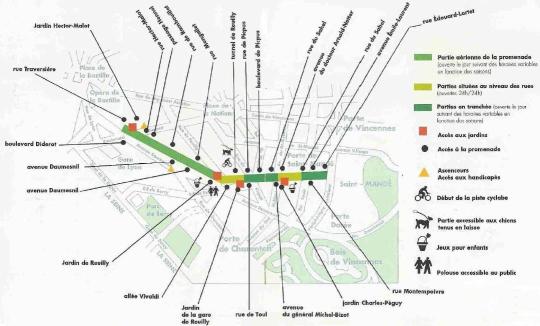

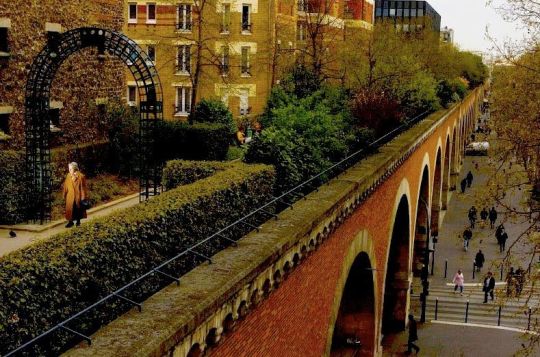

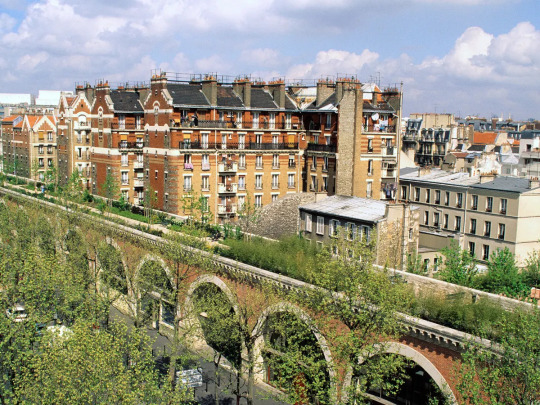


La coulée verte, ou promenade plantée
Promenade plantee map
Map of promenade plantee. Promenade plantee map (Île-de-France - France) to print. Promenade plantee map (Île-de-France - France) to download. The promenade plantee is an original walk, which stretches from the Bastille to the Bois de Vincennes, takes you sometimes in the air and sometimes underground. The promenade plantee unique design will take you from viaduct to footbridge, from tunnel to trench, through the East of Paris. It was created in 1988 by Philippe Mathieux and Jacques Vergely, on the site of the old railway line that linked Place de la Bastille to Varenne-Saint-Maur since 1859. Disused in 1969, it gave way to a succession of gardens scattered over 4.5 kilometers: Hector Malot, Reuilly, Reuilly station, Charles-Peguy as its shown in promenade plantee map. Paris has some of Europe most beautiful parks but for something different search out the Promenade Plantee. The promenade plantee its magical, green stroll 10 metres above the street, which begins at the Bastille and winds through the 12th arrondissement for three miles as its shown in promenade plantee map, coming out before the Bois de Vincennes. When a long-abandoned mid-19th century viaduct was converted into the world first elevated park walkway in 1993, most locals thought it a waste of money. Parisians needed time to take a project like this to heart, but now the Promenade is a cherished landmark.
The promenade plantee crosses the entire length of the 12th arrondissement of Paris (4.5 km as its mentioned in promenade plantee map). The promenade plantee follows the route of an old railway line which ceased to be used in 1969. The terminus station was at the Bastille at the current location of the opera house, the trains went to Boissy-Saint-Léger where there is now the RER A. The promenade plantee starts behind the Bastille Opera House. It overlooks the avenue Daumesnil up to the Reuilly garden: it is the famous Viaduc des Arts. The Vivaldi alley is then the commercial part of the promenade. Then this one continues in tunnels and trenches and one ends up joining the golden door and the wood of Vincennes.
Escape Routes: Discover the Promenade Plantée, the Green Heart of Paris Before New York’s High Line there was Paris’ Promenade Plantée – an elevated walkway fashioned from a disused railway that threads together arts venues, bars and parks in the southeastern part of the city. Culture Trip’s Paris correspondent Eleanor Aldridge explores the route. Running above the mêlée of streets, squares and rail lines that crisscross southeast Paris, the Promenade Plantée is a green needle piercing the city’s heart. Beneath this elevated walkway, motos weave in and out of traffic, crowds gather near Place de la Nation for the latest protest and modern developments butt up against some of the 12th arrondissement’s most community-focused neighbourhoods. Ten metres above, a secret world awaits. Construction of the Promenade Plantée, officially known as the Coulée Verte René-Dumont, finished in 1993 – that’s 21 years before the arguably better-known High Line in New York. It runs for nearly five kilometres between Bastille and Vincennes, along a disused rail line that was once plied by chuntering steam trains.
The paved path cuts through parks and old tunnels, while arched green trellises are festooned with roses and framed by cherry blossom in spring. In winter the path becomes starkly beautiful, set against the imperious Haussmannian façades that run alongside it. It’s not only a great walking route – offering peeks into apartments along the way – but the Promenade Plantée also acts as a ready-made itinerary for exploring this corner of the city. Steps make it easy to nip down to street level, or it takes about an hour to walk to the wilds of the Bois de Vincennes.
Viaduc des Arts
The 19th-century railway arches running along Avenue Daumesnil were among the first stretches beneath the Promenade Plantée to be developed. Now known as the Viaduc des Arts, they house bars, studios, restaurants and gallery spaces. Confiture Parisienne is a must-visit: pick up a jar of award-winning jam – perhaps carrot, passionfruit and vanilla – or try a preserve-making class at the weekend. At airy bar-restaurant Gamelle, there’s also bowling, darts and table football, while the food spans hot dogs, tapas and French classics.
Ground Control
Founded six years ago, Ground Control has become the city’s hub for street food, pop-ups, events with a social conscience and anything in between. Sprawling across what was once an enormous SNCF train shed, it encompasses an open-plan food court, several bars, a shop and open spaces used for everything from yoga to painting classes. The buzzy terrace is the place in Paris to find a great spritz and an even better burger, cooked in a refurbished bus.
Bois de Vincennes
The Promenade Plantée ends at the city’s eastern green lung, the Bois de Vincennes – the mirror image of the Bois de Boulogne, west of the city centre. Making up for the lack of parks in central Paris, its 2,459 acres span lakes and woodland interlaced with shady pathways. Once a royal hunting ground, it’s the closest you can get to real countryside these days without leaving the city proper. In summer, festivals and concerts keep things lively well into the evening.
This story appears in Issue 6 of Culture Trip magazine: The Sustainability Issue.
3 notes
·
View notes
Text
Courbevoie City Tour Guide France Holiday Destination
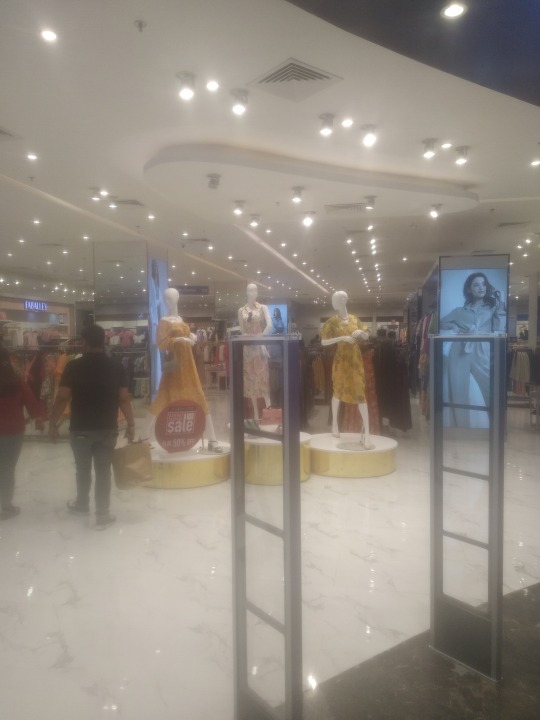
About Courbevoie City destination: Courbevoie is a suburb of the Paris city in France country, Europe. Courbevoie suburb is a good destination to explore local French people social modern life style.
Distance from Courbevoie: Courbevoie suburb city is very well jointed to other France regional places via air, train and road transport. Courbevoie suburb city is just 9.8 KM distance from Paris city centre, Reims city is just 163.7 KM distance, Amiens city is just 138.0 KM distance, Orleans city is just 133.1 KM distance, Le Mans city is just 209.0 KM distance and Le Havre coastal city is just 189.5 KM distance.
France tour: It is a well idea to France country tour which is located in Europe region. France country is situated in northern of the Spain country, Southern of the UK and western of the Germany country. France country some major cities are Paris central capital city and Marseille a port city. Europe holiday tour booking, Japan holiday tour and Switzerland holiday tour booking.
How can come to Courbevoie: Courbevoie is a suburb of the Paris city in France country, Europe. Courbevoie suburb city is very well connected to other European countries and France regional places via air, train and road transport. other countries people can come to Courbevoie (Paris city) via air transport where has two international airports.
Air Transport: Paris Charles de Gaulle International airport is the busiest international airport of the Paris city where passengers can get air flights to other overseas countries.
Paris Airport-Le Bourget International airport is the second international airport of the Paris city where passengers can get air flights to other foreign countries and France native places also.
Water Transport: Courbevoie suburb city is not a coastal or port city where has not water transport services to other overseas countries and France native places. But people can boating and other water sports into the Seine River.
Train Transport: Gare du Nord is the busiest international railway station of the France country where passengers can get train transport to other European cities and France regional places.
Courbevoie City tourists attractions: Courbevoie suburb city city has lots of modern and historical places to visit which some are Parc de Becon - Park, Sports Area Jean-Pierre Rives - Sports complex, Parc des Bruyeres - City park, Aquatic Center Colombes - Aquatic centre, Marcel Payen Sports Complex, Pont de Levallois - Bridge, Intermarche - Supermarket, Square Silvain - Park, Paroisse Saint Maurice de Becon - Catholic church, Stade Olympique Yves du Manoir - Stadium, Parc Pierre Lagravere - Park, Louis Vuitton Foundation - Art museum, Parc Bagatelle - la Roseraie - Garden, Bois de Boulogne - Park, Roland Garros Stadium - Sports complex, National Estate of Saint-Cloud - State park etc.
Courbevoie City famous Restaurants & accommodations: Courbevoie suburb city has several modern and luxury hotels to stay. Courbevoie suburb city some popular restaurants are Bistro d'Edouard - Esplanade de la Defense - Restaurant, IT - Italian Trattoria La Defense - Fast food restaurant, Le Tournesol - Haute French restaurant, So Thai - Thai restaurant, Sha Village - Chinese restaurant, The arts - Restaurant, Brasao - Restaurant, Pizza Ottima's - Au Feu de Bois - Pizza restaurant, Laser World La Defense - Laser tag center, Restaurant Istanbul - Turkish restaurant, L'Atelier - Restaurant, Asian Touch - Restaurant, Aux Delices Parisiens Colombes, Bubble Vib’s Bubble Tea et waffle sucre - Restaurant, The Ranch Restaurant Colombes - Halal restaurant etc.
2 notes
·
View notes
Text
January 30th, Havana to Santi Spiritus
Up for breakfast, Gracie did do a great job of providing a variety at breakfast. Hopped on our coach bus that will be our means of transportation for the next two weeks, Adrian is our driver. As we travel through the country side, Jackson fills us in on the history of Cuba, from the revolt against the Spanish , 1868, to more 20th century what happened after 1959 when the
Americans left. The mass exodus of Cubans to the US in the early 1980’s as well as 1994. There are presently 3 million Cubans living in countries other than Cuban, and many of these people send money back to their relatives in Cuba. Ever since Russia has removed their financial support of Cuba, both the government and people in Cuba rely on this financial support from relatives abroad. Presently local people welcome Euros, and Canadian dollars, they deposit it in banks and us a debit card tied to this account to purchase hard to get food and household goods. Families are given food stamp books that entitle them to 28 staple food items if they are available. That is why foreign currency is welcome because they can use it to supplement the food stamp foods. We have been given anywhere from 80 - 1.05 pesos equivalent for our Canadian dollars.
As we drive I noticed so many horses with Odense carts being driven by locals, some as taxis, others transporting palm leaves, bags of grain and fruit. Fencing for the fields consist of trees, I don’t know what kind, planted a foot apart and then a wire or two strung across.
Arrived in Santa Clara and stopped at Los Caneyes a hotel/restaurant that is very nature conscious and lots of birds, chickens and stray roofed buildings. Buffet lunch all you can eat. Cubans love meat, so Larry is in piggy heaven.
Bit of trivia… National tree, Royal Palm tree, national bird, Tokororo, white, red and blue and the national flower is the Butterfly lily.
Our fellow travellers are seasoned travels and been to everywhere we have been plus more places as well. The gentleman from Paris has been on more than 10 G Adventure tours. Interesting that every one of them is single.
Arrive in Sancti Spiritus and go tour our hotel a beautiful old Casa, actually more of a mansion that has been converted into a hotel, Hotel del Rijo.
Took a walk around the town, many beautiful old mansions and the town square is so clean and welcoming. Walked down to the River, Rio Yayabo it is chocked full off water hyacinths are far as the eye can see. Next on the the local church when we see a statue of the patron saint of Cuba, la Virgen de la Cardad. This blue church dates back to the 1700’s.
At 7:30 we meet for dinner and walk to a local restaurant and have spaghetti Cuban style and my limonada came with a fluorescent ice cube that changed colours. Meal total was < 1400 pesos and that included a 20% tip.
Off to bed, the room is beautiful, beds comfortable and it is quiet. A really pleasant night.
2 notes
·
View notes